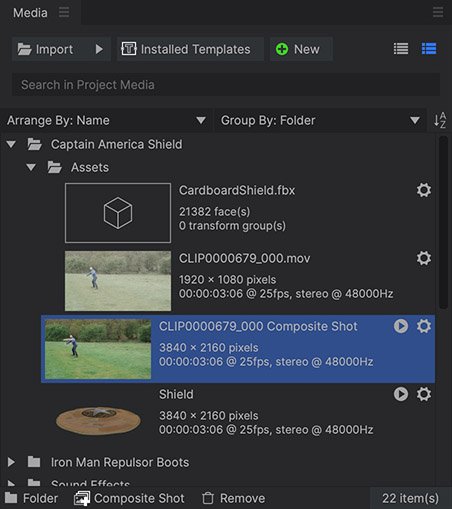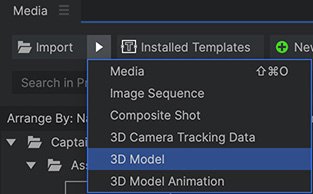In order to use media files in your project, you first need to import the files you want to use. Once imported, they become assets in the Media panel, where they can be accessed and re-used as many times as you want.
Importing media to your project does not alter or affect the original source files on your computer, as HitFilm only references the original files. Therefore removing a clip from a timeline or from the Media panel does not remove it from your computer. Similarly, duplicating a clip in a HitFilm project does not create multiple copies of the source, as they all reference the same source.
Therefore, if you wish to transfer a project to another computer you must make sure all project media is also included.
Importing Files
The Media panel is where you import files into HitFilm, and where you store and organize the files which have been imported.

To import video. audio, or image files into HitFilm, do one of the following:
- Import Button: Click the Import button in the media panel to open a file browser window, where you can select the file(s) to import.
- Drag and Drop: If you already have a file browser open to the location of the files you want, you can drag and drop the files from Windows file browser into the Media Panel of HitFilm.
- Keyboard Shortcut: Press the keyboard shortcut SHIFT+CTRL+O to open a file browser window, where you can select the file(s) to import. On a Mac, the shortcut is SHIFT+CMD+O.
Importing Image Sequences
There are a variety of ways to import image sequences. Use whichever option works best for your circumstances.
- Import Button: Click the Import button in the media panel to open a file browser window, where you can select the file(s) to import. You do not need to select the entire image sequence. Instead, use one of the following options:
- Select a Single Image: Select any single image which is part of the image sequence, and click Open. A prompt will appear asking if you wish to import the selected image, or the image sequence. This prompt can be enabled/disabled at File > Options > Prompts and Warnings.
- NOTE: You can also select individual images from multiple image streams, to import multiple image streams at once.
- Select an Image Range: You can import a portion of an image sequence by selecting the first and last images of the range you wish to import, then clicking Open.
- NOTE: You can import multiple ranges, by selecting the first and last images of the range you want from each image sequence.
- *Drag and Drop: If you have told HitFilm to always import image sequences, via the prompt that appears when you use the Import button, then you can drag and drop a single image from an image sequence into the Media panel, and HitFilm will automatically import the entire sequence.
- Select a Single Image: Select any single image which is part of the image sequence, and click Open. A prompt will appear asking if you wish to import the selected image, or the image sequence. This prompt can be enabled/disabled at File > Options > Prompts and Warnings.
Importing Other Formats ![]()
Clicking the triangular arrow to the right of the Import button displays additional import options.

- Media: This is the option accessed by clicking the Import button. Used for importing videos, individual images and audio.
- Image Sequence: This option is used for importing sequential images stored in a single folder. Images should be numbered sequentially, in frame order. This command converts all images contained in the sequence into a single media object, which is listed in the media panel as a video file.
- Composite Shot: Use this option for importing HitFilm projects (.hfp) and composite shot (.hfcs) files. See Saving Composite Shots for more details.
- 3D Camera Tracking Data: Allows you to import camera tracking data in the .ma format, from software including Boujou, SynthEyes, PFtrack and more. This will create a new composite shot containing the 3D camera and point cloud.
- 3D Model: This is for importing 3D objects, which can then be manipulated on the HitFilm timeline. See Importing 3D Models for more information.
- 3D Model Animation: Choose this option for importing animation files, in the .abc (Alembic) or .fbx (Filmbox) formats. These are used in combination with an associated 3D model.
Once an item is in the Media panel you can customize its properties by clicking the gear icon to its right, or choosing Properties from its menu.
Importing Templates
Templates are a special type of composite shot, which allow you to specify which elements of the composite shot can be edited. Multiple templates are installed into the software, but they remain hidden until they are imported into the software from the media panel. This way, only the templates you are using appear in the media panel.
- Templates Button: Click this button to view a list of the installed templates, and select specific templates for import.
For more information on creating your own templates, see Creating Templates with Composite Shots.
Syncing Video and Audio
If your video and audio are recorded in separate files, you can sync them in the HitFilm media panel. Select the video file in the media panel, then hold CTRL (CMD on Mac) and select the associated audio file. Right-click on either of the files, and select “Merge Audio/Video.” HitFilm will compare the audio in both files, synchronize them, then replace the original audio in the video with the audio file you selected. A new synchronized file will be created, and can then be edited on the timeline. For more info see Audio and Video Sync.
